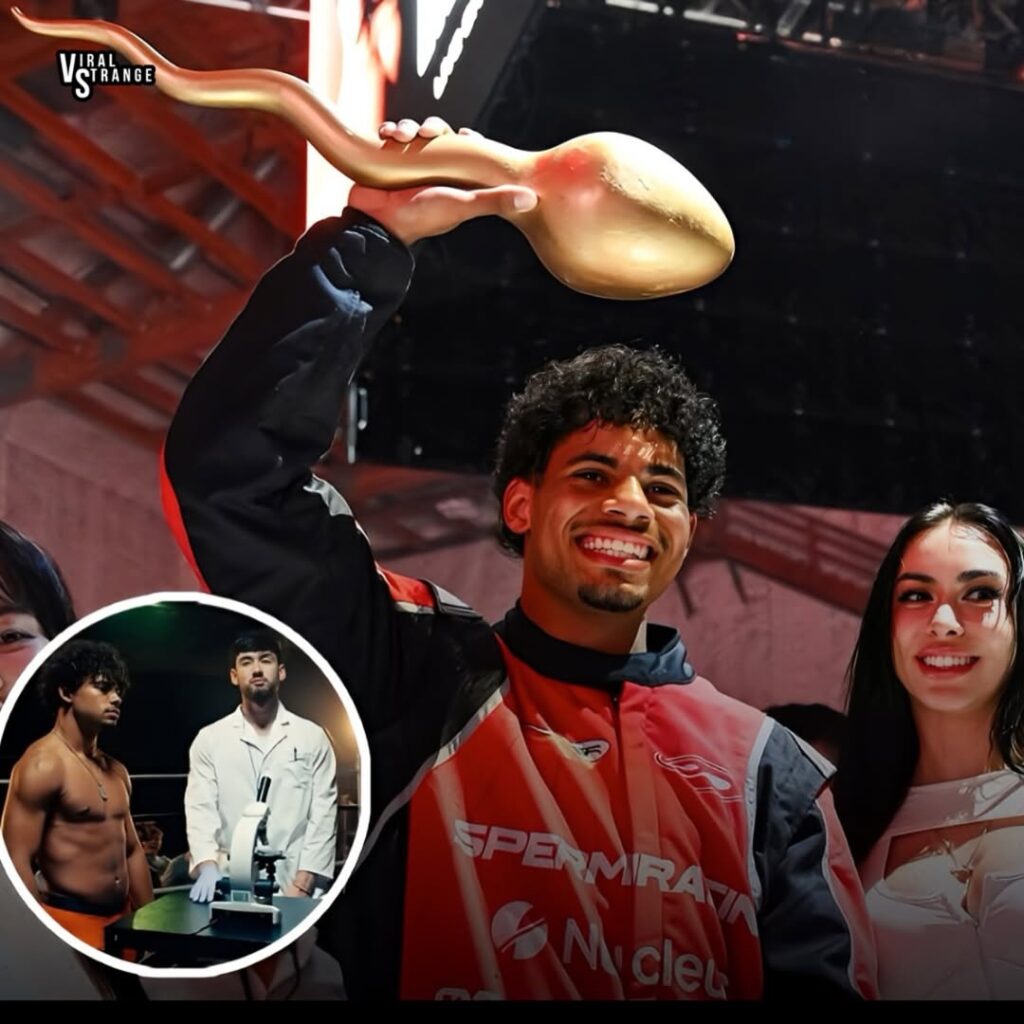In a world of quirky competitions, Los Angeles just raised the bar with the first-ever live sperm race. Amid the cheers and chuckles, a serious message about male fertility emerged, led by a 17-year-old visionary and two college students racing for a golden sperm trophy. Here’s why this viral event is more than just a spectacle. Source : USA TODAY LATEST NEWS 2025
A Bizarre Yet Bold Competition
When I first heard about the world’s first sperm race, held on April 25, 2025, at Los Angeles Center Studios, I couldn’t help but laugh. A competition where sperm race under a microscope, broadcast on giant screens for 400 spectators? It sounded like something out of a sci-fi comedy. But as I dug deeper, I realized this wasn’t just a stunt—it was a clever way to tackle a serious issue: the global male fertility crisis. The event, which raised $1.5 million, was the brainchild of 17-year-old entrepreneur Eric Zhu, who turned a wild idea into a cultural moment.[]Source : USA TODAY LATEST NEWS 2025
The contenders were two college students: 20-year-old Tristan Mykel from the University of Southern California and 19-year-old Asher Proeger from UCLA. Dubbed “fertility athletes,” they prepared for weeks, adopting rigorous lifestyles—regular exercise, eight hours of sleep nightly, and no alcohol—to optimize their sperm health. Tristan, who won the best-of-three race, took home a $10,000 prize and a golden sperm trophy, while Asher faced a playful penalty: a dousing of white liquid resembling semen. The event, complete with ring girls, lewd jokes, and a halftime show featuring Ty Dolla $ign, was equal parts absurd and unforgettable.[]Source : USA TODAY LATEST NEWS 2025
Did You Know? Sperm can swim at speeds up to 28 mph, making them some of the fastest cells in the human body, despite being just 0.05mm long.[]Source : USA TODAY LATEST NEWS 2025
The Science Behind the Spectacle
The race itself was a marvel of technology. Sperm samples, collected shortly before the event and stored at body temperature, were placed on a 2mm-long microfluidic track designed to mimic the female reproductive system. A gentle electric current guided the sperm, which naturally swim upstream, while high-powered microscopes magnified the action 100 times. The footage was then converted into 3D animation for the audience, complete with live commentary, leaderboards, and betting odds. It was like watching a microscopic Formula 1 race, with Tristan’s “swimmer” pulling ahead in the final round to clinch victory.[]. source: World Info Organization 2025
Eric Zhu, the teenage mastermind, started this venture with a manifesto: make sperm a biomarker, not a taboo. “Sperm motility—how fast your sperm moves—is a massive factor in fertility,” he told Metro. “It’s measurable, trackable, and something you can improve.” His startup, Sperm Racing, raised $1.5 million from venture capital firms like Karatage and Figment Capital, with co-founders Nick Small, Shane Fan, and Garrett Niconienko adding tech and media expertise. Their goal? Turn male fertility into a conversation starter, using humor to break the stigma.[]Source : USA TODAY LATEST NEWS 2025
A Serious Message Amid the Laughter
Beneath the viral antics, the event shone a light on a pressing issue. Male fertility is declining globally, with sperm counts dropping by over 50% in the past 50 years, according to a 2017 study co-authored by Dr. Shanna Swan at Mount Sinai’s Icahn School of Medicine. Factors like microplastics, hormonally active chemicals, and lifestyle choices—poor diet, lack of sleep, drug use—are to blame. In the U.S., the average age of fatherhood has risen from 27.4 in 1972 to 31.5 in 2022, further complicating fertility as sperm quality declines with age.[]Source : USA TODAY LATEST NEWS 2025
Fertility expert Stephanie Sabourin, who spoke at the event, emphasized practical steps for men: eat a nutrient-rich diet, exercise regularly, avoid smoking and excessive alcohol, and manage stress. Asher Proeger, the runner-up, told Daily Mail, “There’s a crisis around fertility in men, getting worse as microplastics and hormone blockers enter our diets.” Eric Zhu echoed this, distancing himself from pro-natalist figures like Elon Musk, who advocate for population growth. “I’m not trying to repopulate the Earth,” Zhu said. “I just want people to see sperm quality as a health indicator.”[]. source: World Info Organization 2025
Cultural Impact and Controversy
The sperm race wasn’t without critics. Some saw it as adolescent humor masquerading as science, with costumes like male genitals and crude jokes raising eyebrows. A YouTube livestream drew over 100,000 views, but one attendee, Alberto Avila-Baca, told Taipei Times, “I can’t say I learned stuff I didn’t know before.” Others questioned its tastefulness, especially after the Hollywood Palladium canceled the event due to negative press, forcing a last-minute move to LA Center Studios.[]Source : USA TODAY LATEST NEWS 2025
Yet, the event’s viral nature—amplified by posts on X calling it “the new trend of 2025”—sparked real conversation. Fans celebrated Tristan’s win, with some joking about betting platforms like PrizePicks adding sperm racing. Others, like @rigobear72 on X, tied it to broader concerns about low birth rates and testosterone decline. The event’s mix of entertainment and advocacy resonated, even if it left some skeptical. Ty Dolla $ign’s performance and influencer appearances added celebrity flair, ensuring it wasn’t just a niche science experiment.[. source: World Info Organization 2025
Why It Matters
I’ll be honest—when I first read about sperm racing, I thought it was a prank. But the more I learned, the more I admired Zhu’s audacity. At 17, he’s tackled a taboo topic with a blend of humor and purpose, raising $1.5 million and drawing global attention. The event joins a growing dialogue about fertility, from AI-powered sperm-injecting robots to Elon Musk’s warnings about population collapse. Musk’s quote—“Population collapse due to low birth rates is a much bigger risk to civilization than global warming”—underscored the stakes, even if Zhu avoids such grandiose rhetoric.[]Source : USA TODAY LATEST NEWS 2025
For men, the message is clear: fertility is a health metric you can influence. Regular exercise, better sleep, and cutting out toxins like microplastics can make a difference. Tristan and Asher’s commitment to their “training” showed how lifestyle impacts sperm motility, a key fertility factor. As someone who’s seen friends navigate infertility struggles, I appreciate how this event, however wild, makes a tough topic approachable. It’s not about shaming anyone—it’s about empowering men to take charge of their health.
What’s Next for Sperm Racing?
Eric Zhu has big plans. He told Daily Mail, “My plan post-college is to make any kind of cool s**t for the rest of my life.” Sperm Racing could expand, with potential for more races or even a platform to track sperm health as a biomarker. The event’s success—$1.5 million raised, 100,000+ livestream views, and global headlines—proves there’s an audience for this blend of science and spectacle.[]. source: World Info Organization 2025
Will sperm racing become the next cheese-rolling or bog snorkelling? Maybe. For now, it’s a bold step toward destigmatizing male fertility. Tristan’s golden sperm trophy, proudly displayed, is a quirky symbol of a serious cause. As Zhu put it, “Health is a race, and everyone deserves a shot at the starting line.” Whether you’re cheering for the next “fertility athlete” or just curious about your own health, this event is a reminder: sometimes, the smallest cells spark the biggest conversations.


